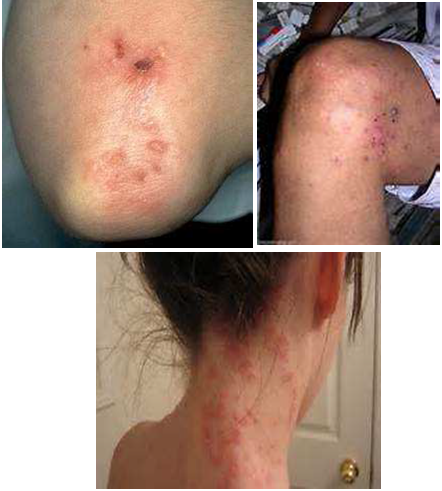
Correspondence:
Received: January 01, 1970 | Published: ,
Citation: DOI:
Download PDF
Introduction and background
- Diagnosed in 1999 with Celiac Disease
- Process took one whole year before getting my final diagnosis, 2 family Physicians and 2 Dermatologists.
- At that time there were very few gluten free options.
- My family’s diagnosis
Celiac Disease
- Immune response in the small intestine when ingesting gluten found in wheat, barley and rye products. Damage to the villi and lack of absorption of nutrients.
- Classic symptoms: abdominal pain, cramps, bloating, diarrhea, anemia, weight loss, bone pain.
Celiac Disease and Dermatitis Herpetiformis
- Otherwise known as DH
- Skin form of Celiac. Extremely red and itchy bumps and blisters, hurts and itches at the same time!
- Classic location of rash: found on knees, elbows, buttocks, scalp.
- Usually no GI symptoms (Figure 1)

Figure 1 Examples of DH.
Gluten sensitivity
- Individuals who cannot tolerate gluten
- Does not trigger the immune response
- Hence does not show any GI symptoms or damage
- Becoming more recognized
- Currently unsure if gluten sensitivity has any long term health affects
- No current testing is available
- Diet
Hereditary links and Population
- Prevalent in Scandinavian and Celtic roots
- 1% of Americans or 3 million are diagnosed
- 97% are undiagnosed
- Those with a autoimmune diseases is more likely to also develop Celiac disease.
DH-the unbearable itch!
- Common age ranges are 15- 40 yr of age
- More common in women than men
- Only affects 15-25% of those with celiac disease
- Dapsone antibiotic. “Old fashioned” 1950s drug
- Also used to treat AIDS related pneumonia and Leprosy
- Does have side affects
Stressors
- “Trauma” can trigger Celiac disease, therefore, it may lay dormant for many years.
- Pregnancy
- Car accident
- Death
- Divorce
- High stress environment
Testing
- Blood testing: anti-tissue transgluteaminase (tTG)
- Anti-endomysium (EMA)
- Anti-demidated gliagin peptides(DGP)
- Biposy- from small intestine or skin for DH
- Must be eating gluten for at least 12 weeks to confirm
- Genetic testing to confirm carrier of DQ2 and DQ8 genes
Diet
- Healing varies from person to person
- Potato, rice, soy and bean flours
- Can include all plain fruits, vegetables, meats and dairy
- Gluten Free choices that are available
- Hidden gluten sources
Deficiency of nutrients
- Iron, folic acid, and calcium
- Vitamins-A, B-12, D, E and K
- Affects on body
- Supplementation
New labeling law
- New law in affect Aug 2, 2013, manufacturers have a year to be in compliance http://www.fda.gov/NewsEvents/Newsroo m/PressAnnouncements/ucm363474.htm
- Reports must be 20 ppm or less to be labeled as gluten free.
- This also includes all dietary supplements and restaurants claiming gluten free on their menu.
- Not required to place gluten free on an specific location on the product.
- Not required to have uniform symbols.
Popularity
- Restaurants
- Gluten Free diet as a “Cure all” for weight loss or other diseases/conditions
- Credible sources.
Conclusion
- If properly diagnosed, Celiac disease is manageable.
- Following a gluten free diet can reverse affects over time.
- Being gluten free does not mean you have to give up eating all the foods you like.
- Read labels and educate.
Acknowledgements
Conflicts of interest
The author declares no conflict of interest.

© . This is an open access article distributed under the terms of the,
which
permits unrestricted use, distribution, and build upon your work non-commercially.


